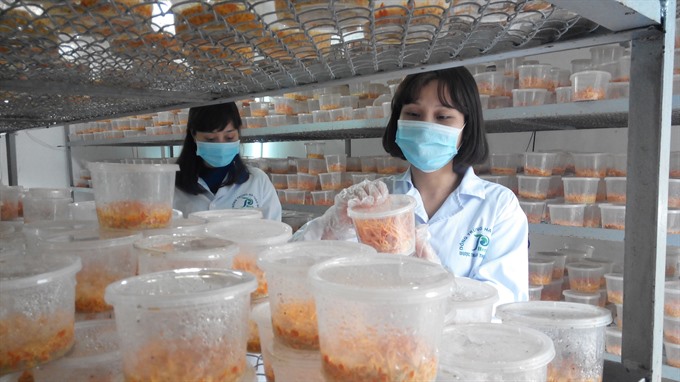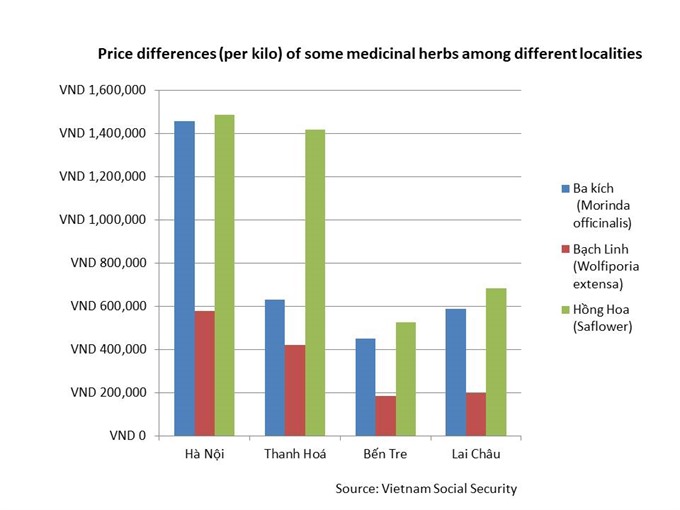 Society
Society

The use of herbal medicine is on the rise among Vietnamese in recent years, but concerns about management and arbitrary pricing are growing, too.
 |
| Workers check the development of đông trùng hạ thảo (Cordyceps sinensis) at Thiên Phúc Herbal Joint Stock Company in Hà Nội’s Thanh Oai District. – VNA/VNS Photo Mạnh Khánh |
HÀ NỘI – The use of herbal medicine is on the rise among Vietnamese in recent years, but concerns about management and arbitrary pricing are growing, too.
Shop owners claim there are many medicines that can cure all diseases, even fatal ones. The price of traditional medicines varies widely between companies and health facilities, the online Vietnamplus reported.
Statistics from the Traditional Medicine Management Department under the Ministry of Health showed that many medicinal substances share name but differ greatly in price.
Take Bạch cập or Dix Stemonae Tuberosea, one of 237 herbs the department listed as an example.
The price of the root and body of Bạch cập differed between companies. The price was declared at VNĐ3.9 million (US$172) per kilo by Thăng Long Pharmaceutical Oriental Medicine Joint Stock Company, nearly VNĐ5.1 million ($225) by Thiên Ân Limited Company and VNĐ8.7 million ($383) by Vietnam Medicinal Materials Joint Stock Company.
Đan sâm (or Radix Salviae Miltiorrhizae) varied similarly. The price of this medicine was listed at VND206,000 ($9) by Đồng Hưng Đường Co.Ltd, more than triple the price of VND 64,000 ($3) by Khang Minh Pharmaceutical Company.
Such price differentials were recorded at hospitals as well.
Trần Văn Ơn, head of the Department of Botany under the Hà Nội University of Pharmacy, said the bid winning price for each kind of traditional medicine might differ between hospitals by a factor of six or 10.
"This indicates that management in terms of quality and price of materials for traditional remedies in the public sector is not uniform," Ơn said.
Vietnamplus also reported that the price of ba kích (Indian Mulberry or Morinda officinalis) differered between localities. For instance, the price was VNĐ338,000 ($15) per kilo in Quảng Nam Province while in Thanh Hóa and Điện Biên Province it was VNĐ 630,000 ($28) and VNĐ730,000 ($32), respectively.
According to the Department of Management of Traditional Medicine (Ministry of Health), the management of imported pharmaceuticals faces many challenges.
Most households engaged in trading medicinal substances in Ninh Hiệp Commune in Hà Nội’s Gia Lâm District and in
Some pharmaceutical companies and a number of drug manufacturers have bought materials from the above-mentioned households.
Meanwhile, these companies and manufacturers must show documents to prove the products’ origin while taking part in bidding to provide materials for hospitals. As a result, they must undertake measures to legalise their business.
Trần Hồng Phương, deputy director of the Traditional Medicine Management Department, attributed the difference in medicinal substance to the Ministry of Health’s regulation, which requires drugs imported into Việt
Domestic demand for traditional pharmaceuticals is high in
 |
Statistics from the health sector showed that the pharmaceutical industry consumes between 40,000-60,0000 tonnes of traditional or herbal medicinal materials per year. Around 80 per cent were imported from foreign countries on small scale.
Phạm Lương Sơn, deputy director general of Việt Nam Social Insurance (VSI), said various shortcomings exist in examination and treatment for health insurance holders relating to traditional medicine.
According to him, the price of medicinal herbs set during the bidding process did not reflect their origin and quality.
Sơn noted Bạch truật (or Atractylodes macrocephala Koidz) as an example.
The bid winning price for this kind of medicine was over VNĐ134,000 ($6) at the lowest level in
The representative of VSI also blamed loose management on facilities engaged in manufacture and trade of traditional medicine for the high price of medicinal herbs.
Some medicinal herbs could be cultivated in Việt
Nguyễn Tá Tỉnh, head of Pharmacy and Health Facilities Department under the VSI, said the price of many medicinal herbs rose by 60 per cent from 2014 to 2016.
He blamed the bidding councils for this. The bidding councils should set a single price so as to narrow the price differential between localities, thus achieving a reasonable winning price.
In the coming months, the VSI would co-ordinate with the Traditional Medicine Management Department to inspect a number of provinces to review the price, Tinh said. — VNS




